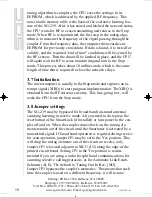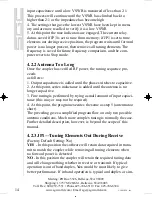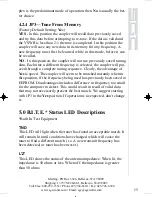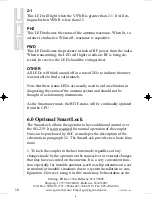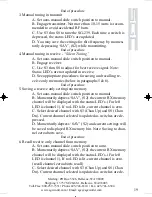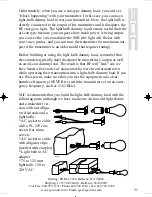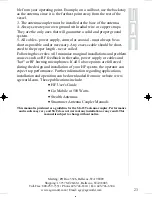
Mailing: PO Box 3526, Bellevue, WA 98009
Shipping: 13737 SE 26th St., Bellevue, WA 98005
Toll-Free: 800-259-7331 • Phone 425-746-6310 • Fax: 425-746-6384
www.sgcworld.com • Email: [email protected]
8
© 2001 SGC, Inc.
3.2 Tuning Process
An array of detector devices in the SG-239 monitor the antenna sys-
tem impedance, reactance signal, and the VSWR load when RF
power is applied to the unit. The coupler also monitors forward
power, since the control computer requires an indication of both for-
ward and reflected power in order to allow tuning to proceed. The
computer uses the forward power detector as a check to ensure that
the measurements made are applied RF and are not spurious levels
from the data conversion system. The SG-239 will proceed to tune
only when enough forward power is present to confirm this check.
After RF is applied to the detector system, it then passes through the
coupler tuning array. The coupler tuning array consists of six capaci-
tors in shunt on the input arm of the network, seven inductors in the
series arm, and four more capacitors in shunt on the output arm, all
arranged in binary increments. Relays are provided in conjunction
with each lumped constant and allow removal or entry as desired. A
network having 64 values on input shunt C, 16 values of output
shunt C, and up to 128 values of series L is possible with the ma-
nipulation of these 17 relays.
3.3 Impedance Detector
RF transformers T1 and T3 drive the impedance bridge that is bal-
anced at 50 ohms. T3 samples the line current and thus D7 out-puts a
negative DC level proportional to line current. A tertiary winding on
transformer T1 provides a line voltage sample to D2 that provides a
positive voltage proportional to line voltage. R18 and R11 act as a
summing network for the current and voltage signals, with ratios
chosen, such that at 50 ohms, the summed signals result in a bal-
anced or zero voltage condition. If the line impedance goes to high,
the signal from the voltage sensor will be relatively higher than the
current sensor, which will result in a net positive output voltage from
the summing network. Similarly, a low line impedance will result in
more output from the current sensor, resulting in a net negative out-
put voltage from the summing network. The summing network out-
put is shifted to a 0 to 5v range, then fed to the processor's A to D
converter port, and used within the micro-controller.
SG-239 Manual
page 8
Wednesday, October 17, 2001 08:31
Composite










